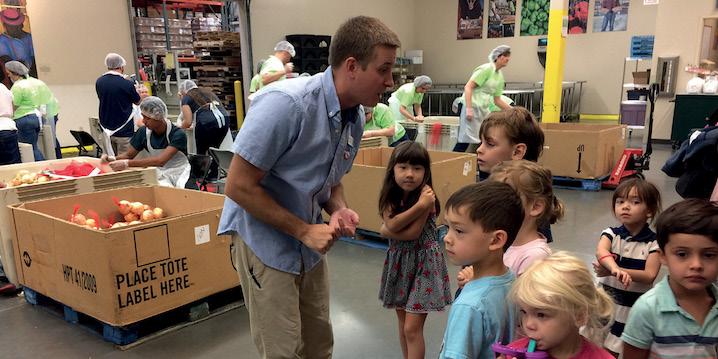
Hunger is far from unknown at my house: We struggle to get both girls — Edie, 4, and Maxine, 2 — to eat, so many evenings are filled with stubborn, hangry kids.
I’ve known other kinds of hunger, too: It wasn’t so long ago that I had to ask the grocery checker to put back a box of cereal because I’d miscalculated how much I had left in the month’s food stamps.
When I was pregnant with Edie and when she was a baby, I worked for a nonprofit through AmeriCorps, and then as a freelance writer; my husband, Eric, was working two jobs and going to graduate school. We could barely afford our apartment in Tigard and relied on WIC (Women, Infants and Children) vouchers for staples like infant oatmeal and soy milk, as well as the debit-version of food stamps, the Oregon Trail Card. I once cried in the checkout line, mortified, because I’d chosen the wrong size jars of baby food, which didn’t qualify for WIC, and I could feel the impatient, judgmental gaze of the customers behind me as a manager fixed my mistake.
We are fortunate that we no longer struggle to fill our fridge, but 20 percent of Oregonians face food insecurity, and nearly a quarter-million kids in Oregon don’t have enough to eat, according to the Oregon Food Bank.
Hunger is a social ill that’s relatively easy for kids to grasp: Some people don’t have enough food.
Yet I wanted my girls to get a more complete sense of the issue, so I organized a trip to the Oregon Food Bank headquarters in North Portland.
A handful of my friends and their kids joined us for a tour. The kids watched, wide-eyed, as volunteers packed thousands of onions into mesh bags for distribution, and they poked in the dirt that grew green beans, thyme and jalapeños for emergency food centers across the Portland metro area. The littles were especially excited that they got to pick a tomato of their own, and they ran around the garden with seeds stuck to their chins.
On the drive home from the food bank, we talked about families that have to skip meals. “How would you feel if you didn’t get lunch?” I asked. From her car seat, Edie thought. “Hungry,” she said.
For me, it’s important that I discuss not only social problems with my kids, but also how we can all help. So after Edie imagined what it would be like to contend with an empty stomach, I asked, too, what she thought we could do about it.
“We can give them food,” she said. We talked about how our donations to the food bank that day would get delivered to people who needed it.
The food bank visit was just one entry point in an ongoing conversation I have with Edie and Maxine. Another example: I keep zippered baggies in my car filled with individual portions of peanut butter, granola bars and other snacks, plus tissues and new socks. When we pause at a highway exit where someone’s cardboard sign is asking for help, I offer a baggie. “What did you give him, Mama?” Edie always asks — a natural conversation starter.
The baggie is such a small gesture — a few items we stock up on at the dollar store — but I hope we’re giving a something more than a snack. At the least, I’m giving my kids a sense that they’re not powerless in the face of such a huge problem.
The other day, the girls and I were at the grocery store. I asked Edie and Maxine if they wanted to pick out some items to donate to our town’s food drive.
They were excited: They zipped down the aisles, picking up boxes of pasta and cans of soup. “This, Mama?” Maxine asked. “This? This?”
I made a visual checklist of food banks’ most-needed food items that even pre-readers can use as a sort of shopping list. (See the list below and make your own at home!) Kids can search for items like canned tuna and spaghetti sauce as if they’re in a scavenger hunt for cupboard staples. We’ll be using it this holiday season and beyond when we go grocery shopping. I know that food pantries can do more with cash — they can buy food 20 times more cheaply than you or I, by some estimates — but we shop for donations in addition to giving money so my kids also learn real-world applications of sharing and empathy.
Three-quarters of a million Oregonians will deal with hunger this year, a far-reaching problem that requires systemic change in policy, employment, housing and the cycles of poverty. But my kids are too little to understand how lobbying for, say, more inclusive health care can lower rates of food instability.
What they can understand is that food feeds the hungry. We’ll work on that — the simple help that even a child can offer.

 Oregon Food Bank’s list of most needed food items:
Oregon Food Bank’s list of most needed food items:
Peanut butter and almond butter (low or no sugar)
Rice
Tuna
Beans (canned or dried)
Pasta
Whole-grain cereal
Shelf-stable milk
Cooking oil
Canned tomatoes
Other nutritious foods (preferably healthy, whole-grain, low-fat, low-sodium and low-sugar products)
- Family-Friendly Winter Travel Around Oregon - November 30, 2023
- Catch Fall Colors at Hoyt Arboretum - November 1, 2023
- Family-Friendly Travel for Your Best Oregon Summer Yet - May 23, 2023





